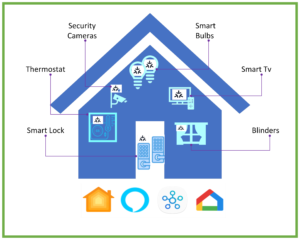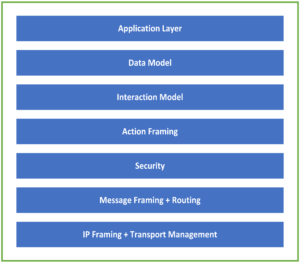The idea of Smart Homes for over a decade has taken the world by storm. This B2B/ B2C market segment offers attractive options and millions of homes around the world, arguably, already qualify as smart homes. Home buyers have plentiful IoT enabled smart home devices to choose from but have yet to deliver the desirable customer experiences. The key reason being the home automation industry’s suffering from its growing pains due to proprietary software and systems.
Current Scenario in Home Automation using the Smart Home Devices
Smart Home Devices, to bring value to any and every home, are yet to meet the expectations of the consumer. Often, consumers need to make trade-offs between having the various devices they truly desire and the capability of those devices to work well in a seamless installation. The reason being connected products, in the Smart Homes are not yet easy to buy, configure, install, as easy as the regular ones. For a user, any smart bulb, blind, door lock, should be easy to discover, and use without any expert knowledge or per say, assistance.
Smart home devices are supposed to make your life easier and more convenient, but installing a bunch of disparate internet-connected devices that don’t work together might complicate it instead. A user must go by many set up screens just to turn on a light bulb. And the next smart thing to be bought from the store takes up altogether a different exercise. Whereas, any smart bulb, blind, door luck, should be easy to discover, and use without any expert knowledge or per say, assistance. This has led to many situations where smart home devices are returned due to set up issues. The devices when successfully up and running, connected via the cloud are vulnerable, thus posing a risk for the security and privacy of the homebuyer. Smart home devices as individual products are doing their job. But these multiple smart products from various vendors and to work as an ecosystem together often has proven to be challenging.
Thus, we can say that the key issues for the home automation industry are convenience, security, and energy efficiency.
The issue of inconvenience is technically a big part of the problem and has been in existence for an exceptionally long time due to the variety of standards and protocols, such as Wi-Fi, Bluetooth, Zig-bee, Z-Wave and Thread. There have been difficulties in using them not only from the physical connection perspective, but also the issue of different means of communication at the application layer.
Matter solves these problems. But what is Matter? And how does it help?
Matter is an open, royalty free standard for Home Automation, managed by Connectivity Standards Alliance. Matter uses a wireless technology based on Internet Protocol that lets devices work across all major Smart Home platforms like Apple, Google, Amazon Alexa and many more.
Matter uses Thread (802.15.4), Wi-Fi, and Ethernet for transport and Bluetooth LE for commissioning. It uses the ZCL (Zig bee Cluster Library) as a data model which defines the end node capability and its role through different types of clusters and its attributes. Just to be clarify, Matter does not replace existing platforms, it gives multi-Admin control, which means, it allows you to connect several Matter-enabled platforms and devices with the same account, taking universal interoperability even further. Simply put, Smart Home devices now have a universal language- Matter Protocol, enabling them to share information across ecosystems giving a consistent setup experience across all Matter-enabled devices. Also, as Matter protocol is based on Internet Protocol, it has Lower latency and higher reliability standard as compared to the other Cloud-to-cloud connections.
The solutions with Matter have a good deal for both the users and manufacturers, as the matter devices built once will work for all Matter-certified ecosystems. Hence, lower development costs and time, more features embedded into the smart devices help faster time to market.

Matter Enabled Home Automation System
Layers of Matter, explained
As mentioned earlier, Matter aims to build a universal IPv6-based communication protocol for smart home devices. The protocol defines the application layer that will be deployed on devices as well as the different link layers to help maintain interoperability. The following diagram illustrates the normal operational mode of the stack:

Application and Network Stack
The architecture is divided into layers to help separate the different responsibilities and introduce a good level of encapsulation amongst the various pieces of the protocol stack. Majority of interactions flow through the stack captured in the following:

Layered Architecture
- The Application layer corresponds to the high order business logic of a device. For example, an application that is focused on lighting might contain logic to handle turning on/off a light bulb, as well as its color characteristics.
- The Data Model layer corresponds to the data and verb elements that help support the functionality of the application.
- The Application operates on these data structures when there is intent to interact with the device.
- The Interaction Model layer defines a set of interactions that can be performed between a client and server device. For example, reading or writing attributes on a server device would correspond to application behavior on the device. These interactions operate on the elements defined at the data model layer. Once an action is constructed using the Interaction Model, it is serialized into a prescribed packed binary format to encode for network transmission. This process is handled in the Action Framing layer.
- An encoded action frame is then processed by the Security Layer: the message is encrypted and appended with a message authentication code. These actions ensure the data remains confidential and authentic between sender and receiver of the message. With an interaction now serialized, encrypted, and signed, the Message Layer constructs the payload format with required and optional header fields, which specify properties of the message as well logical routing information. After the final payload has been constructed by the Message Layer, it is sent to the underlying transport protocol (TCP or Matter’s Message Reliability Protocol) for IP management of the data. Once the data is received on the peer device, it travels up the protocol stack, where the various layers reverse the operations on the data performed by the sender, to finally deliver the message to the Application for consumption.
Smart Home Device’s Commissioning in Matter
Device commissioning is the process of joining a device to a Fabric. The device being commissioned is referred to as the Commissionee and the device administering commissioning is referred to as the Commissioner. Device commissioning consists of the following steps:
- Device discovery “On boarding Pay load”: The Commissioner discovers commissionable devices on network interfaces such as Bluetooth Low Energy, Wi-Fi, or another connected IP network. The Commissioner obtains the out of-band secret (Passcode) from the commissionable device’s QR Code, Manual Pairing Code, NFC Tag or other means. This secret is used by Passcode-Authenticated Session Establishment (PASE) to establish a secure commissioning session. The order of discovering commissionable devices and obtaining the out-of-band secret from commissionable device is not critical.
- Security setup with PASE “Pass Code-Authenticated Session Establishment (PASE): Establish encryption keys between the Commissioner and Commissionee using PASE. All messages exchanged between the Commissioner and Commissionee are encrypted using these PASE-derived keys. The process also establishes an attestation challenge used during the device attestation procedure.
- Device attestation verification “Device Attestation”: Commissioner establishes the authenticity of the Commissionee as a certified device, notifying the user if the device is not certified.
- Information configuration “Node Operational Credentials Specification”, “General Commissioning Cluster” and “Node Operational Credentials Cluster”: The Commissioner provides Commissionee with information such as regulatory domain, UTC time, Operational Certificate and network interfaces configuration.
- Join network “Network Commissioning Cluster” and “Operational Discovery”: The Commissioner triggers the Commissionee to connect to the operational network unless the Commissionee is already on the operational network. The Node’s/ Commissionee’s IPv6 address is then either used (if already known) or discovered (if not known) by the Commissioner or Administrator.
- Security setup with CASE “Certificate Authenticated Session Establishment (CASE)”: Derive encryption keys used to establish secure communication between the Commissioner or Administrator and Node with CASE. All unicast messages between a commissioner or Administrator and a Node are encrypted using these CASE-derived keys.
- Commissioning complete message exchange “General Commissioning Cluster”: A message exchange encrypted using CASE-derived encryption keys on the operational network that indicates successful completion of commissioning process. A commissioner can reconfigure the Commissionee multiple times over the operational network after the commissioning is complete or over the commissioning channel after PASE-derived encryption keys are established during commissioning.
One goal of this standard is to provide support for low energy Nodes running on limited power sources such as batteries or limited energy scavenging. The Sleepy End Device (SED) operating mode is defined to help extend and optimize battery lifetimes for such Nodes. The SED operating mode mirrors and aligns with Thread SED behavior, but may be leveraged over other supported IP interfaces, including Wi-Fi.
Want to develop a Matter based Solution?
The bare minimum set up to create Matter network requires one Matter over Thread or Matter over Wi-Fi development kit and one set of devices creating the ecosystem (matter controller + thread border router).

Matter based Solution
Companies from across the industry are contributing market-proven Technologies and Best Practices. Glide has multiple customized successful solutions based on Matter, utilizing SoCs (system on chips) or Devkits of all leading semiconductors companies such as Nordic, NXP, Silicon Labs, Espressif, Dialog and many others.
At Glide Technology, we provide End-to-end Product Engineering Services covering all aspects of product life cycle starting from concept research to market-ready product for various industries such as Wearables, IoT, Healthcare, Smart Home and more. For Smart Home Device Development, we will become your engineering partner in adoption of Matter in your Product Development Roadmap.
References Links:





